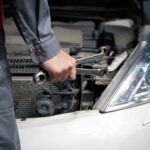A vehicle that requires few consumables
An electric motor requires much simpler maintenance than a combustion engine. Not subject to mechanical friction and liquid and gas flow exchanges, it requires neither lubricant nor exhaust. And it therefore does not require oil change, filter change or replacement of the exhaust line. It’s all less on the cost of maintaining the car. Maintenance therefore concerns far fewer mechanical elements than in a thermal car. In addition, tire sets, windshield washer fluid, brake pads and even air conditioning filters are the only consumables to be changed regularly on an electric car.
A low number of parts
The design of the electric car motor drastically reduces the number of parts needed to operate it. Among them, no so-called “wear” part can corrupt its integrity. Thus, on an electric vehicle , neither timing belt, cylinder head gasket, nor hose can cause engine failure: as far as traction is concerned, these cars are reliable for hundreds of thousands of kilometres. For drivers who need peace of mind, in addition to easy maintenance, the electric car is therefore an obvious choice. Especially since simple maintenance does not mean less rigorous maintenance: all the parts of the vehicle are checked by experts within the manufacturer’s network.
Less brake wear
Electric cars use two braking systems: first , regenerative braking , which uses the motor like a generator to recharge the battery from time to time, and traditional braking – disc or drum, with pads – which then engages. The mechanical system and the tires are therefore less stressed, which favors a less frequent change of the dedicated parts.
A simplified transmission
In the absence of a manual gearbox and clutch, the transmission of an electric vehicle is carried out much more simply: unlike a heat engine, an electric motor provides the rotation directly. When the driver presses the accelerator, the battery generates a magnetic field at a fixed part which causes the rotation of a moving part. On Groupe Renault electric vehicles, the latter is a wound rotor, which increases the energy efficiency of the motor. All failures associated with the traditional transmission system are therefore avoided, and the maintenance cost inherent in this function is reduced.
Traditional checkpoints
Maintenance of the chassis, bodywork, tyres, steering and suspension of an electric vehicle is carried out in the traditional way, as is the checking of the air conditioning system, comfort elements or wipers. ice cream. These checkpoints are essential for vehicle safety and driving comfort.
Reduced do-it-yourself maintenance
On an electric vehicle, the brake fluid and coolant levels must be checked, and possibly replaced or supplemented. The inflation pressure of the tires should also be checked periodically as for a combustion engine car: before leaving on vacation, before a technical inspection, etc. Another operation that can be done without going to the garage: changing the 12-volt battery every three years, like that of the Renault ZOE , which ensures the operation of the lighting and electronics.
Should the battery of an electric vehicle be maintained?
The battery of an electric vehicle is one of its most important elements. The motor is powered by the so-called “traction battery”. It ensures the autonomy of the electric car over several hundred kilometers depending on the model.
As for the durability of a lithium-ion battery for an electric vehicle, the Renault Group, an electric pioneer , estimates it at ten years of automotive life. But this does not mean that the battery does not work afterwards, on the contrary. It still has a good ten years to show its effectiveness and usefulness. Indeed, many areas exploit the second life of electric car batteries : stationary electricity storage, electrification of vehicles, distribution of green energy in short circuits, etc.
How you use the vehicle also affects battery life. It is therefore essential to entrust its follow-up to a Renault dealer. To ensure optimal longevity, it verifies the life cycle of this crucial part. In addition, Renault guarantees its batteries for a period of eight years or 160,000 kilometers for ZOE, five years or 100,000 kilometers for Kangoo Electric, and three years or 60,000 kilometers for Twizy in order to maintain a charge capacity of at least 66% in all circumstances.








Leave a Reply
You must be logged in to post a comment.